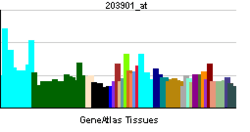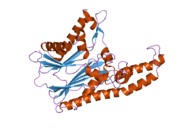MAP3K7IP1
Mitogen-activated protein kinase kinase kinase 7-interacting protein 1 is an enzyme that in humans is encoded by the MAP3K7IP1 gene.[1][2][3]
Function
The protein encoded by this gene was identified as a regulator of the MAP kinase kinase kinase MAP3K7/TAK1, which is known to mediate various intracellular signaling pathways, such as those induced by TGF beta, interleukin 1, and WNT-1. This protein interacts and thus activates TAK1 kinase. It has been shown that the C-terminal portion of this protein is sufficient for binding and activation of TAK1, while a portion of the N-terminus acts as a dominant-negative inhibitor of TGF beta, suggesting that this protein may function as a mediator between TGF beta receptors and TAK1. This protein can also interact with and activate the mitogen-activated protein kinase 14 (MAPK14/p38alpha), and thus represents an alternative activation pathway, in addition to the MAPKK pathways, which contributes to the biological responses of MAPK14 to various stimuli. Alternatively spliced transcript variants encoding distinct isoforms have been reported.[3]
This protein plays an important role in skin homeostasis,[4][5] wound repair,[6][7] and oncogenesis.[8]
Interactions
MAP3K7IP1 has been shown to interact with:
References
- ↑ Shibuya H, Yamaguchi K, Shirakabe K, Tonegawa A, Gotoh Y, Ueno N et al. (July 1996). "TAB1: an activator of the TAK1 MAPKKK in TGF-beta signal transduction". Science 272 (5265): 1179–82. doi:10.1126/science.272.5265.1179. PMID 8638164.
- ↑ Sakurai H, Miyoshi H, Toriumi W, Sugita T (May 1999). "Functional interactions of transforming growth factor beta-activated kinase 1 with IkappaB kinases to stimulate NF-kappaB activation". J Biol Chem 274 (15): 10641–8. doi:10.1074/jbc.274.15.10641. PMID 10187861.
- ↑ 3.0 3.1 "Entrez Gene: MAP3K7IP1 mitogen-activated protein kinase kinase kinase 7 interacting protein 1".
- ↑ Omori E, Matsumoto K, Sanjo H, Sato S, Akira S, Smart RC et al. (July 2006). "TAK1 is a master regulator of epidermal homeostasis involving skin inflammation and apoptosis.". J. Biol. Chem. 281 (28): 19610–19617. doi:10.1074/jbc.M603384200. PMC 1797070. PMID 16675448.
- ↑ Sayama K, Hanakawa Y, Nagai H, Shirakata Y, Dai X, Hirakawa S et al. (August 2006). "Transforming growth factor-beta-activated kinase 1 is essential for differentiation and the prevention of apoptosis in epidermis.". J. Biol. Chem. 281 (31): 22013–22020. doi:10.1074/jbc.M601065200. PMID 16754690.
- ↑ Tan SH, Pal M, Tan MJ, Wong MH, Tam FU, Teo JW et al. (July 2009). "Regulation of cell proliferation and migration by TAK1 via transcriptional control of von Hippel-Lindau tumor suppressor.". J. Biol. Chem. 284 (27): 18047–18058. doi:10.1074/jbc.M109.002691. PMC 2709347. PMID 19419968.
- ↑ Lam CR, Tan MJ, Tan SH, Tang MB, Cheung PC, Tan NS (January 2011). "TAK1 regulates SCF expression to modulate PKBα activity that protects keratinocytes from ROS-induced apoptosis.". Cell Death Differ. 18 (7): 1120–9. doi:10.1038/cdd.2010.182. PMID 21233843.
- ↑ Omori E, Matsumoto K, Zhu S, Smart RC, Ninomiya-Tsuji J (November 2010). "Ablation of TAK1 upregulates reactive oxygen species and selectively kills tumor cells.". Cancer Res. 70 (21): 8417–8425. doi:10.1158/0008-5472.CAN-10-1227. PMC 2970664. PMID 20959492.
- ↑ 9.0 9.1 Takaesu G, Kishida S, Hiyama A, Yamaguchi K, Shibuya H, Irie K et al. (April 2000). "TAB2, a novel adaptor protein, mediates activation of TAK1 MAPKKK by linking TAK1 to TRAF6 in the IL-1 signal transduction pathway". Mol. Cell 5 (4): 649–58. doi:10.1016/s1097-2765(00)80244-0. PMID 10882101.
- ↑ Bouwmeester T, Bauch A, Ruffner H, Angrand PO, Bergamini G, Croughton K et al. (February 2004). "A physical and functional map of the human TNF-alpha/NF-kappa B signal transduction pathway". Nat. Cell Biol. 6 (2): 97–105. doi:10.1038/ncb1086. PMID 14743216.
- ↑ 11.0 11.1 11.2 Cheung PC, Nebreda AR, Cohen P (February 2004). "TAB3, a new binding partner of the protein kinase TAK1". Biochem. J. 378 (Pt 1): 27–34. doi:10.1042/BJ20031794. PMC 1223947. PMID 14670075.
- ↑ 12.0 12.1 Ninomiya-Tsuji J, Kishimoto K, Hiyama A, Inoue J, Cao Z, Matsumoto K (March 1999). "The kinase TAK1 can activate the NIK-I kappaB as well as the MAP kinase cascade in the IL-1 signalling pathway". Nature 398 (6724): 252–6. doi:10.1038/18465. PMID 10094049.
- ↑ Channavajhala PL, Wu L, Cuozzo JW, Hall JP, Liu W, Lin LL et al. (November 2003). "Identification of a novel human kinase supporter of Ras (hKSR-2) that functions as a negative regulator of Cot (Tpl2) signaling". J. Biol. Chem. 278 (47): 47089–97. doi:10.1074/jbc.M306002200. PMID 12975377.
- ↑ Sakurai H, Miyoshi H, Mizukami J, Sugita T (June 2000). "Phosphorylation-dependent activation of TAK1 mitogen-activated protein kinase kinase kinase by TAB1". FEBS Lett. 474 (2-3): 141–5. doi:10.1016/s0014-5793(00)01588-x. PMID 10838074.
- ↑ Ge B, Gram H, Di Padova F, Huang B, New L, Ulevitch RJ et al. (February 2002). "MAPKK-independent activation of p38alpha mediated by TAB1-dependent autophosphorylation of p38alpha". Science 295 (5558): 1291–4. doi:10.1126/science.1067289. PMID 11847341.
- ↑ Edlund S, Bu S, Schuster N, Aspenström P, Heuchel R, Heldin NE et al. (February 2003). "Transforming growth factor-beta1 (TGF-beta)-induced apoptosis of prostate cancer cells involves Smad7-dependent activation of p38 by TGF-beta-activated kinase 1 and mitogen-activated protein kinase kinase 3". Mol. Biol. Cell 14 (2): 529–44. doi:10.1091/mbc.02-03-0037. PMC 149990. PMID 12589052. Vancouver style error (help)
- ↑ Yanagisawa M, Nakashima K, Takeda K, Ochiai W, Takizawa T, Ueno M et al. (December 2001). "Inhibition of BMP2-induced, TAK1 kinase-mediated neurite outgrowth by Smad6 and Smad7". Genes Cells 6 (12): 1091–9. doi:10.1046/j.1365-2443.2001.00483.x. PMID 11737269.
- ↑ Walsh MC, Kim GK, Maurizio PL, Molnar EE, Choi Y. Unutmaz D, ed. "TRAF6 autoubiquitination-independent activation of the NFkappaB and MAPK pathways in response to IL-1 and RANKL". PLoS ONE 3 (12): e4064. doi:10.1371/journal.pone.0004064. PMC 2603309. PMID 19112497.
- ↑ Yamaguchi K, Nagai S, Ninomiya-Tsuji J, Nishita M, Tamai K, Irie K et al. (January 1999). "XIAP, a cellular member of the inhibitor of apoptosis protein family, links the receptors to TAB1-TAK1 in the BMP signaling pathway". EMBO J. 18 (1): 179–87. doi:10.1093/emboj/18.1.179. PMC 1171113. PMID 9878061.
- ↑ Sanna MG, da Silva Correia J, Luo Y, Chuang B, Paulson LM, Nguyen B et al. (August 2002). "ILPIP, a novel anti-apoptotic protein that enhances XIAP-mediated activation of JNK1 and protection against apoptosis". J. Biol. Chem. 277 (34): 30454–62. doi:10.1074/jbc.M203312200. PMID 12048196.
- ↑ Kurozumi K, Nishita M, Yamaguchi K, Fujita T, Ueno N, Shibuya H (April 1998). "BRAM1, a BMP receptor-associated molecule involved in BMP signalling". Genes Cells 3 (4): 257–64. doi:10.1046/j.1365-2443.1998.00186.x. PMID 9663660.
Further reading
- Kurozumi K, Nishita M, Yamaguchi K, Fujita T, Ueno N, Shibuya H (1998). "BRAM1, a BMP receptor-associated molecule involved in BMP signalling.". Genes Cells 3 (4): 257–64. doi:10.1046/j.1365-2443.1998.00186.x. PMID 9663660.
- Yamaguchi K, Nagai S, Ninomiya-Tsuji J, Nishita M, Tamai K, Irie K et al. (1999). "XIAP, a cellular member of the inhibitor of apoptosis protein family, links the receptors to TAB1-TAK1 in the BMP signaling pathway.". EMBO J. 18 (1): 179–87. doi:10.1093/emboj/18.1.179. PMC 1171113. PMID 9878061.
- Ninomiya-Tsuji J, Kishimoto K, Hiyama A, Inoue J, Cao Z, Matsumoto K (1999). "The kinase TAK1 can activate the NIK-I kappaB as well as the MAP kinase cascade in the IL-1 signalling pathway.". Nature 398 (6724): 252–6. doi:10.1038/18465. PMID 10094049.
- Dunham I, Shimizu N, Roe BA, Chissoe S, Hunt AR, Collins JE et al. (1999). "The DNA sequence of human chromosome 22.". Nature 402 (6761): 489–95. doi:10.1038/990031. PMID 10591208.
- Kishimoto K, Matsumoto K, Ninomiya-Tsuji J (2000). "TAK1 mitogen-activated protein kinase kinase kinase is activated by autophosphorylation within its activation loop.". J. Biol. Chem. 275 (10): 7359–64. doi:10.1074/jbc.275.10.7359. PMID 10702308.
- Sakurai H, Miyoshi H, Mizukami J, Sugita T (2000). "Phosphorylation-dependent activation of TAK1 mitogen-activated protein kinase kinase kinase by TAB1.". FEBS Lett. 474 (2-3): 141–5. doi:10.1016/S0014-5793(00)01588-X. PMID 10838074.
- Ono K, Ohtomo T, Sato S, Sugamata Y, Suzuki M, Hisamoto N et al. (2001). "An evolutionarily conserved motif in the TAB1 C-terminal region is necessary for interaction with and activation of TAK1 MAPKKK.". J. Biol. Chem. 276 (26): 24396–400. doi:10.1074/jbc.M102631200. PMID 11323434.
- Qian Y, Commane M, Ninomiya-Tsuji J, Matsumoto K, Li X (2001). "IRAK-mediated translocation of TRAF6 and TAB2 in the interleukin-1-induced activation of NFkappa B.". J. Biol. Chem. 276 (45): 41661–7. doi:10.1074/jbc.M102262200. PMID 11518704.
- Yanagisawa M, Nakashima K, Takeda K, Ochiai W, Takizawa T, Ueno M et al. (2002). "Inhibition of BMP2-induced, TAK1 kinase-mediated neurite outgrowth by Smad6 and Smad7.". Genes Cells 6 (12): 1091–9. doi:10.1046/j.1365-2443.2001.00483.x. PMID 11737269.
- Ge B, Gram H, Di Padova F, Huang B, New L, Ulevitch RJ et al. (2002). "MAPKK-independent activation of p38alpha mediated by TAB1-dependent autophosphorylation of p38alpha.". Science 295 (5558): 1291–4. doi:10.1126/science.1067289. PMID 11847341.
- Sakurai H, Nishi A, Sato N, Mizukami J, Miyoshi H, Sugita T (2002). "TAK1-TAB1 fusion protein: a novel constitutively active mitogen-activated protein kinase kinase kinase that stimulates AP-1 and NF-kappaB signaling pathways.". Biochem. Biophys. Res. Commun. 297 (5): 1277–81. doi:10.1016/S0006-291X(02)02379-3. PMID 12372426.
- Ge B, Xiong X, Jing Q, Mosley JL, Filose A, Bian D et al. (2003). "TAB1beta (transforming growth factor-beta-activated protein kinase 1-binding protein 1beta ), a novel splicing variant of TAB1 that interacts with p38alpha but not TAK1.". J. Biol. Chem. 278 (4): 2286–93. doi:10.1074/jbc.M210918200. PMID 12429732.
- Ishitani T, Kishida S, Hyodo-Miura J, Ueno N, Yasuda J, Waterman M et al. (2003). "The TAK1-NLK mitogen-activated protein kinase cascade functions in the Wnt-5a/Ca(2+) pathway to antagonize Wnt/beta-catenin signaling.". Mol. Cell. Biol. 23 (1): 131–9. doi:10.1128/MCB.23.1.131-139.2003. PMC 140665. PMID 12482967.
- Suzawa M, Takada I, Yanagisawa J, Ohtake F, Ogawa S, Yamauchi T et al. (2003). "Cytokines suppress adipogenesis and PPAR-gamma function through the TAK1/TAB1/NIK cascade.". Nat. Cell Biol. 5 (3): 224–30. doi:10.1038/ncb942. PMID 12598905.
- Tanno M, Bassi R, Gorog DA, Saurin AT, Jiang J, Heads RJ et al. (2003). "Diverse mechanisms of myocardial p38 mitogen-activated protein kinase activation: evidence for MKK-independent activation by a TAB1-associated mechanism contributing to injury during myocardial ischemia.". Circ. Res. 93 (3): 254–61. doi:10.1161/01.RES.0000083490.43943.85. PMID 12829618.
- Channavajhala PL, Wu L, Cuozzo JW, Hall JP, Liu W, Lin LL et al. (2004). "Identification of a novel human kinase supporter of Ras (hKSR-2) that functions as a negative regulator of Cot (Tpl2) signaling.". J. Biol. Chem. 278 (47): 47089–97. doi:10.1074/jbc.M306002200. PMID 12975377.
- Cheung PC, Nebreda AR, Cohen P (2004). "TAB3, a new binding partner of the protein kinase TAK1.". Biochem. J. 378 (Pt 1): 27–34. doi:10.1042/BJ20031794. PMC 1223947. PMID 14670075.
| |||||||||


